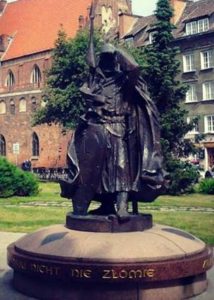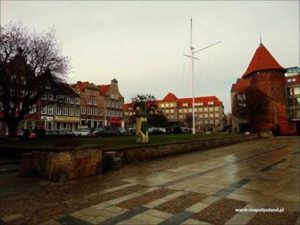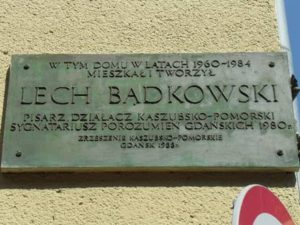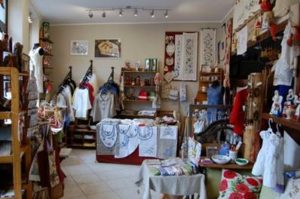Kashubians for ages have been constituting a historical part of Gdansk’s population. The city has always been appealing for people from many cultures which also played a part in forming quite an intricate history. Gdansk is often called Polish „window to the world” because that’s where the biggest Polish river flows into the Baltic sea. At the end of the 12th century German colonists came to Gdansk and over time removed Pomeranians from local institutions and tried to take over these territories. However, situation was the worst for Kashubians after Prussia seized Gdansk. German settlers despised poor fishermen, craftsmen and tradesmen which were precisely the social groups where Kashubians dominated.
Many traces of Kashubian activity have survived in Gdansk. Some of them function to this day with an unchanged profile of activity. When strolling about Gdansk we can come across plaques and monuments commemorating notable activists and promoters of Kashubian culture.

In 2010 the monument of Swietopelk the Great, the Duke of Gdansk was unveiled. There’s inscription in Kashubian language written on the pedestal of the monument: Together we will not be broken. The excerpt comes from Kashubian national epic „The Life and Adventures of Remus” by Aleksander Majkowski. The sentence is believed to be pronounced by Swietopelk the Great. The prince brought Dominicans from Krakow who then settled near St. Nicolas church called Fishermen’s Church by Kashubians. The square near the monument has become a meeting place for the Kashubian community of Gdansk. Many events such as the Kashubian Day celebration take place there.

A marketplace in Gdansk. It’s situated in the north-west corner of main town by the Motlawa river near to the former Teutonic castle. It’s one of the places most connected with the Kashubian culture and activity because they engaged in catching and selling fish already in times of the Kashubian Dukes. During the reign of Teutonic knights they continued to engage in this activity and so they did up to the 20th century. Selling fish was primarily a female activity. The main types of fish that were sold fish were herrings, eels, salmons, flounders. After years of break, at the initiative of Kashubian-Pomeranian Association former Fischmarkt was restored, to continue centuries-old tradition.

Lech Bądkowski house was located in Gdansk at the Fish Market (Targ Rybny) 6c/7 street where a commemorative plaque hangs today. He was an honoured worker of Kashubian culture, a writer and a soldier. He was a publicist in „Baltic Journal” (Dziennik Bałtycki) and in other editorial offices but he couldn’t write for too long anywhere due to political reasons. In 1956 he co-founded Kashubian-Pomeranian Association and actively worked in Polish Writers’ Union of Gdansk, which he headed in the years 1957-1966. He also did a lot for Solidarity movement where he was a press secretary and participated in the meetings. Lech Bądkowski was well-educated, he published a lot of works and attended all sorts of conferences and events related to scientific activity. The communist authorities obviously didn’t like that, that’s why they constantly tried to block his work. Therefore, he wasn’t well-known but fortunately his figure is being rediscovered today. He died on the February 24, 1984 in his house at Long street after a long illness.

The headquarters of Kashubian-Pomeranian Association is Kashubian House, situated in Gdansk at Straganiarska 21-23 street. Kashubian-Pomeranian Association was founded on December 2, 1956 and initially was intended to protect and take care of development of Kashubian part of Pomerania. Currently it’s a public service organization, one of the biggest NGO’s in Poland and the biggest in the history of Kashubian movement. They take care of the development of Kashubian-Pomeranian traditions and culture and their spread in society. There’s also a student club ”Pomorania” working by the main authorities. Its premise is to prepare young people to actively participate in public life of the region and the country.

The Gallery of Kashubian art is situated in Gdansk at Świętego Ducha 48 street. Earlier there was a Kashubian publishing house located there. Today tourists can purchase souvenirs related to Kashubian culture here. In the gallery one can find works of art with handmade adornments including popular Kashubian embroidery. Among others: rag-dolls, napkins, tablecloths, objects of everyday use. Majority of the products ara handmade by the local artists.
On the building facing the Świętego Ducha street there’s a commemorative plaque dedicated to Florian Ceynowa who is considered to be the father of the Kashubian regionalism. He lived in Gdansk and that’s where he printed his works. The most popular one is „Rozmowa Polaka z Kaszubą” (A talk of a Pole with a Kashubian), in which he tries to explain complex relations between Poles, considering themselves Kashubians and those who don’t consider themselves Kashubians. He explains what motivates Kashubians to openly acknowledge their identity and also why they are proud of being Kashubians.
Автор: Karolina Ebertowska, студентка I курса Русской филологии Гданьского университета, магистратура
Перевод на английский язык: Gabriela Bednarek, студентка I курса Востоковедения Гданьского университета